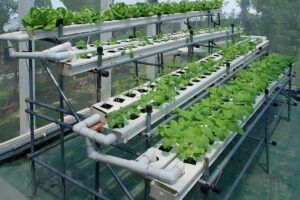Welcome to the world of hydroponics, where you can grow lush, green plants without the need for soil! If you have ever dreamed of having your own thriving garden, rife with fresh herbs, vibrant vegetables, or dazzling flowers, then this step-by-step guide is your gateway to making that dream a reality. With a touch of creativity and a dash of determination, you can unlock the secrets of building your very own home hydroponic system. So grab your tools, put on your planting gloves, and let’s dive into the world of hydroponics, where the possibilities are as boundless as your imagination.
Choosing the Right Hydroponic System for Your Needs
When it comes to building your very own home hydroponic system, selecting the right system for your needs is of utmost importance. With a myriad of options available, it can be overwhelming to determine which one is the perfect fit for you. Let’s break it down, explore the different types, and find the hydroponic system that will make your green thumb thrive.
1. Nutrient Film Technique (NFT): This system uses a shallow tray to allow a thin film of nutrient-rich water to flow continuously over the plants’ roots. It’s an excellent choice for those limited on space, as it requires minimal media and has a low water consumption.
2. Deep Water Culture (DWC): In this system, plant roots are suspended in a nutrient-rich solution, typically oxygenated by an air stone. It’s easy to set up, making it ideal for beginners. Plus, plants grow rapidly as they receive a constant supply of nutrients.
3. Ebb and Flow (Flood and Drain): With this system, the plant roots are periodically flooded with nutrient solution and then allowed to drain. It’s a versatile option that accommodates a wide variety of plants. Additionally, it offers more flexibility in terms of media selection.
Remember, a successful home hydroponic system ultimately depends on understanding your space, your green goals, and the plants you wish to grow. By carefully considering the pros and cons of different systems, you can make an informed decision and embark on an exciting hydroponic journey!
Designing Your Hydroponic System: Factors to Consider
When it comes to building your very own home hydroponic system, there are several important factors to consider in order to ensure its success. These factors will determine the efficiency, productivity, and overall health of your plants. By carefully considering each element, you can create a thriving hydroponic system that will provide you with fresh and healthy produce all year round. Let’s explore the key factors that should be taken into account:
1. Type of Hydroponic System: There are various types of hydroponic systems, each with its own advantages and disadvantages. Some popular options include Deep Water Culture (DWC), Nutrient Film Technique (NFT), and Drip System. Consider the space you have available, your budget, and the type of plants you want to grow. Research each system and choose the one that aligns with your needs and goals.
2. Lighting: Adequate lighting is crucial for the growth of your plants. While natural sunlight is ideal, it may not always be feasible. In such cases, you need to invest in artificial lighting, such as LED or fluorescent grow lights. Determine the light intensity and spectrum required for your plants based on their specific needs and adjust accordingly to ensure optimal growth.
3. Nutrient Solution: The nutrient solution is the lifeblood of your hydroponic system. It provides essential minerals and elements necessary for plant growth. Research the nutrient requirements of your chosen plant varieties and invest in high-quality hydroponic nutrients. It is important to regularly monitor and adjust the pH and nutrient levels of the solution to maintain a balanced and healthy environment for your plants.
Gathering the Essential Materials for Your Hydroponic System
is a crucial step in building your own home hydroponic system. Having the right materials will ensure the success of your system and help you achieve the best possible results. Here are the key items you will need:
1. Growing Containers: Choose containers that are suitable for hydroponic gardening, such as plastic buckets, grow bags, or specialized hydroponic trays. Make sure they have proper drainage holes to prevent waterlogging. The size of the containers will depend on the type and number of plants you plan to grow. Don’t forget to sterilize them before use to prevent any potential contamination.
2. Growing Medium: Unlike traditional soil-based gardening, hydroponic systems use various inert growing mediums to provide support and moisture for the plants’ roots. Some popular growing mediums include coco coir, perlite, vermiculite, or a combination of these. Your choice of growing medium will depend on the type of plants you want to grow and their specific needs.
3. Nutrient Solution: Since hydroponic plants rely on nutrient-rich water instead of soil for their growth, a properly balanced nutrient solution is essential. You can buy pre-formulated nutrient solutions or prepare your own by mixing the required proportions of essential nutrients like nitrogen, phosphorous, and potassium. Be sure to follow the instructions carefully to avoid over or underfeeding your plants.
Step-by-Step Guide to Setting Up Your Home Hydroponic System
Creating your own home hydroponic system may sound daunting, but with this step-by-step guide, you’ll be growing your own fresh produce in no time. Our method is simple yet effective, providing you with all the necessary information to set up and maintain a thriving hydroponic garden, right in the comfort of your own home. So, let’s dive right in and get started!
First things first, you’ll need to gather a few essential materials for your home hydroponic system. Here’s a list of what you’ll need:
– A suitable container or tank to hold the nutrient solution
– Growing medium such as perlite, vermiculite, or coconut coir
– A submersible water pump to recirculate the nutrient solution
– Air stones or diffusers for oxygenation
– LED grow lights or natural sunlight for plant growth
- Nutrient solution specifically formulated for hydroponics
– pH test kit to monitor and adjust the acidity of the solution
– Seeds or seedlings of your desired plants
Once you have all the necessary materials, it’s time to set up your hydroponic system. Begin by filling your container with the chosen growing medium. Make sure it’s moistened adequately, allowing the roots of your plants to settle in comfortably. Place the container near a suitable light source, whether it be natural sunlight or LED grow lights, ensuring that your plants receive at least 8-10 hours of light each day.
Next, it’s time to prepare the nutrient solution. Follow the instructions on your specific hydroponic fertilizer, mixing it with water and adjusting the pH level as instructed. It’s crucial to maintain the correct pH level, typically around 5.5 to 6.5, for optimum nutrient uptake by your plants. Once the solution is ready, submerge the water pump and air stones in the container. The water pump will circulate the nutrient solution, providing your plants with the necessary nutrients, while the air stones or diffusers will oxygenate the solution, promoting healthy root development.
With your hydroponic system set up and running, it’s now time to plant your seeds or seedlings. Gently place them into the growing medium, ensuring their roots are in contact with the nutrient solution. Be mindful of spacing, allowing enough room for each plant to grow and thrive. Over time, monitor the progress of your plants and adjust the light, nutrient solution, and pH levels as needed to maintain optimal conditions.
Building your own home hydroponic system is a rewarding journey that allows you to harvest fresh, nutritious produce all year round. By following this step-by-step guide and providing your plants with the necessary care, you’ll be well on your way to becoming a successful hydroponic gardener. So, grab your materials, get your hands dirty, and watch your garden flourish!
Maintaining and Troubleshooting Your Hydroponic System
In order to ensure the optimal growth and health of your hydroponic plants, it is crucial to maintain and troubleshoot your hydroponic system on a regular basis. By following these simple steps, you can prevent potential issues and keep your system running smoothly.
1. **Monitor pH Levels**: pH is a critical factor in hydroponics as it affects nutrient uptake by the plants. Regularly measure the pH levels of your nutrient solution using a pH meter or test kit. Ideally, the pH should be kept between 5.5 and 6.5 for most plants. If you notice any significant deviations, adjust the pH accordingly by adding pH up or pH down solutions.
2. **Inspect and Clean Equipment**: Regularly inspect all components of your hydroponic system, including pumps, air stones, filters, and tubing. Make sure they are free from debris or signs of wear and tear. Clean any clogged or dirty equipment to prevent blockages and ensure proper functioning. This will help maintain a healthy nutrient flow and prevent nutrient deficiencies in your plants.
3. **Prevent Pest Infestations**: Hydroponic systems can be susceptible to pests such as aphids, spider mites, or fungus gnats. To prevent infestations, implement preventive measures like sticky traps or beneficial insects. Regularly inspect your plants for any signs of pests and take immediate action if detected. Implement natural pest control methods like neem oil or insecticidal soap if necessary. By staying vigilant and proactive, you can keep your plants pest-free and promote their growth.
Remember, is an ongoing process. By following these steps and staying attentive to the needs of your plants, you will be rewarded with healthy and thriving crops. Enjoy the satisfaction of cultivating your own home hydroponic system and the fresh, bountiful harvests it produces. As we draw a close to this hydroponic adventure, we hope you are now positively buzzing with excitement and armed with the knowledge to embark on your own green revolution. By delving into the world of hydroponics, you have joined a community of forward-thinking and innovative gardeners, eager to cultivate their own slice of paradise.
Remember, building your own home hydroponic system is not just about growing fresh produce; it’s about taking control of your environment and embracing a sustainable lifestyle. With each homegrown harvest, you will not only nurture your plants but also your connection with nature.
So, gather your materials, prepare your space, and get your hands dirty – quite literally! From crafting your own nutrient solution to basking in the mesmerizing sight of thriving greenery, this step-by-step guide has equipped you with all the essentials. But don’t stop here; this is just the beginning of your hydroponic journey.
As you embark on this horticultural endeavor, be prepared to learn, adapt, and experiment. Hydroponics is an art that rewards curiosity, patience, and a touch of ingenuity. Each setback will become an opportunity for growth and every success will be a cause for celebration.
By stepping into the realm of hydroponics, you have not only embraced a sustainable way of growing but also unlocked a world of possibilities. Imagine a future where fertile gardens flourish in the most unlikely of places and where food scarcity becomes a mere memory. Your home hydroponic system is not just a source of fresh produce; it is an embodiment of resilience, resourcefulness, and hope.
Now, it is your turn to become the architect of your own bio dome, cultivating a thriving oasis within the walls of your home. As you embark on this hydroponic journey, let the symphony of bubbling water, vibrant greens, and the hum of life guide you towards a greener future. Happy growing!



